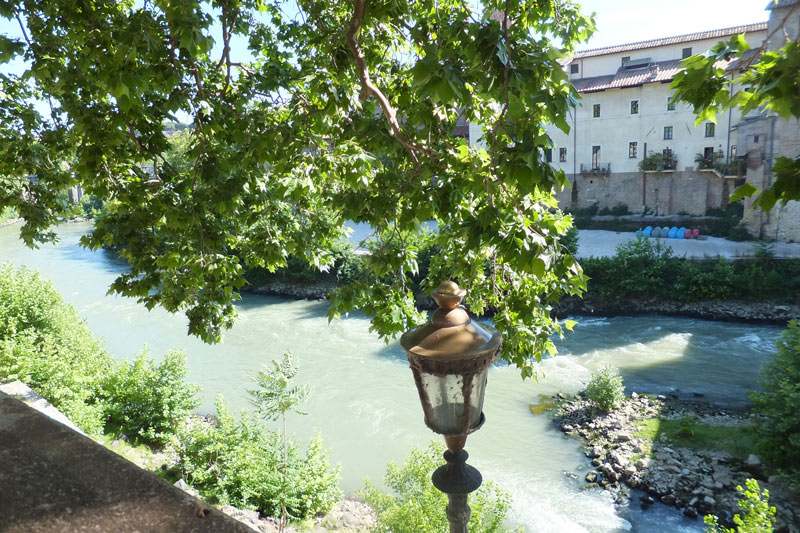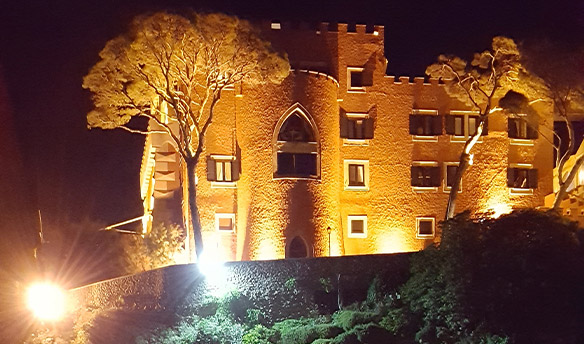Legend has it that, around 290 BC, Roman officials sailed to Epidauro in Greece.
They consulted Aesculapius, the god of medicine, about pestilence that had broken out in Rome. The myth says that a serpent, a symbol of the god, left the Greek temple and boarded the Roman vessel. When the vessel returned to Rome, the serpent climbed onto the Tiberina Island and settled there. The Romans built a temple on the island, dedicated to the god, whereupon the pestilence disappeared. Since then, the island has maintained a medical tradition.

Ponte Rotto, Ponte Fabricio and the island

Ponte Fabricio from the Lungotevere
The island is connected to Rome by two bridges: to the east, the old Ponte Fabricio and, on the western side, the newer and wider Ponte Cestio. There is a third bridge, which must be one of the unluckiest in history. The Ponte Rotto (meaning “broken bridge”) had already collapsed twice when Pope Gregory ordered it to be rebuilt, around 1575. The bridge collapsed again in 1598 and its surviving arch stands to the south of the island.
Ponte Fabricio is sometimes known as the Ponte dei Quattro Capi (the bridge of the four heads). The four carved stone heads at the eastern end of the bridge are said to depict squabbling architects, whom Pope Sixtus V entrusted with the bridge’s restoration. Their arguments led them to blows and, when the work was completed, they were decapitated on the Pope’s orders.
The tower by Ponte Fabricio, facing east, has a small carved face of a woman. According to the story, her father wanted her to marry an old and wealthy man but she refused because she loved someone else.
Her love was away, fighting in a war, and she waited for his return. If you cross Ponte Fabricio towards the island, you will see her, still waiting.


Piazza San Bartolomeo
The Romans’ temple to the god of medicine has long gone, but the island now houses two hospitals.
On the old site of the Temple, at the southern end of the island, is the Basilica di San Bartolomeo and the piazza that bears its name. Alongside the Church is the Ospedale Israelitico (one of three sites of the Jewish hospital in Rome). Its presence on the island is convenient as, opposite the island, on the eastern side, is Rome’s Jewish ghetto.
During the German occupation of Rome, a Catholic nurse, Dora Focaroli, tried to save the hospital’s Jewish patients. She changed the hospital’s name-plate and organised the transfer of many patients to the San Camillo and Fatebenefratelli hospitals. Some Jewish patients and families remained and the Germans became suspicious. The local police commander, Maresciallo Luciniani, denied any knowledge of Jewish patients and subsequently helped the nurse to arrange food supplies for them.

The southern part of the island, including the Ospedale Israelitico, from the eastern Lungotevere

The Fatebenefratelli Hospital viewed from Ponte Fabricio
Alongside the church of San Giovanni Calibita, in the northern part of the island, is the Fatebenefratelli hospital. Its name translates as “Do well brothers” in homage to the monks, its founders. During the German occupation, the hospital staff were active in shielding fugitives. Some of these “patients” were diagnosed with an infectious medical condition, Syndrome K, that reportedly deterred the Germans from coming too close. The “K”, in fact, related either to Kesselring, the head of the German army in Italy or, possibly, Kappler, the head of the gestapo in Rome. Neither the syndrome nor its cure has been identified in medical textbooks …



